Reading time: 1 minute
Digitalisation changes the entire value-added chain of the windows, doors and facades in-dustry. This stretches from sales with online-based sales premises, configuration tools and sales platforms to planning, after-sales service and maintenance based on digital product information.
It goes without saying that windows and doors are also becoming digital with the use of sensors and actuators. New technologies with added value will spread rapidly and lead to disruptive changes. Use of Artificial Intelligence (AI) for processing user and customer data in particular, voice control, 3D printers, objects and items for everyday use with sensors and Internet connectivity (IoT) as well as Virtual Reality (VR) and Augmented Reality (AR) will lead to substantial changes. Analyses of successful online business models demonstrate that savings in costs along with simplified processes and interpretation of customer and user data result in enhanced added value.
Even if the windows industry is not a "Silicon Valley", there are nevertheless, highly promising digital services and products — true to the slogan "Wherever there is a problem, there are opportunities for new and better solutions". Digitalisation will change the industry by the following technologies:
- Virtual sales premises with Augmented Reality (AR) and product configurators,
- CAD and digital planning, calculation and simulation tools,
- Building Information Modelling (BIM) and Computer Aided Facility Management (CAFM)
- Windows construction software with consistent data management for more efficient organisation of all areas — from planning, production, logistics, organisation systems for document management and factory production control (FPC),
- 3-D printers for the production of lot size 1 for components made of plastics, metals or glass,
- Robotics and CNC production with autonomous control and direct connectivity with online shops,
- Online tools for the calculation and design of thermal/sound insulation, structural calculations, CO2 footprint, daylight utilisation, solar gains, ventilation etc.,
- Windows, doors, gates, facades, glass, solar shading with intelligent functions and controls (smart home),
- Technologies for maintenance and servicing (RFID, transponders, sensors and IoT) based on usage data (forces, frequency, maintenance, spare parts etc.),
- Instruction and training of employees in production, installation or laboratory via live streaming and smart glasses.

adaptive and digital in the future and will be configured and planned
with BIM systems in virtual sales premises (Figure: Siemens AG)
Online sales opportunities can enormously expand the sales radius of competent, innovative and flexible companies. Those who can do something special and presents this skill via search engine optimisation (SEO) on the Internet, can acquire customers worldwide. This may benefit handicraft enterprises capable of solving complex problems — this cannot be copied. In the windows sector, this could include windows and building elements with a combination of design and sophisticated functions such as high level of thermal, acoustic and burglary protection.
Entry into digital technologies is not a cost related issue, but a problem of the scarcity of time available with managers and entrepreneurs. The reason for this is that in medium-sized and handicraft enterprises, the entrepreneur is operationally deeply involved and occupied by various management tasks. Rethinking is needed here and digitalisation must be accorded top priority before tasks can be assigned to service providers or employees. Companies have to form networks and cooperate more closely with universities, institutes, associations and software providers.
Extensive use and fast dissemination of digital technologies is slowed down by the following problematic areas:
- Poor network connectivity with insufficient transmission bandwidth,
- The tradition of serial construction with step-by-step bidding,
- The segmentation of construction with several participants and interfaces,
- An execution plan, which runs in parallel with the progress of the construction as well as
- poor digital equipment sometimes of not only many municipalities and authorities, but also of planning offices and handicraft enterprises.
According to a study, the companies can be divided as follows into medium-sized and handicraft hierarchies [1]:
- 10% of the companies will become pioneers concerning digital development of skills and corporate application ("early innovators"),
- 40% of the financially healthy companies will presumably mushroom in time, but still be successful as latecomers in the trend of digitalisation,
- 50% of the companies will remain in denial for a long time until they are no longer competitive at all or are "forced to digitalise" by market developments.
Sales
In essence, digitalisation means nothing more than the creation of digital "images" of physical objects and events as well as analogue communication (language). This data can be collected, saved, analysed and used. In connection with computational and analytical methods (algorithms) patterns are recognised, for which then, actions are defined and executed automatically. Compared to human actions, this is incomparably fast and low-priced. In this way, data becomes an important basis for new businesses. It is not surprising that powerful online portals have evolved, which use the physical resources of others and only organise the facilitation of supply and demand (Uber, airbnb, Flixbus, Verivox, ebay and many others). As soon as one portal is established and gets accepted in a given product area, the rules change fundamentally.
Today, the majority of human beings order products and services online. The purchase of durable and complex products such as windows and doors, however, is still a matter of trust for many, and personal contact is desired. In the process, competent consulting combined with installation is important. In particular, the functional correlation of assembly and building elements as well as the availability in case of complaints and faults is a decisive argument in favour of a local purchase. This is why manufacturers, dealers and installation companies with personal contact to the customer have good opportunities compared to online shops.
Nevertheless, purchase of windows and building elements via good online shops gets established provides a strong competition to traditional sales. The same rules apply to online sales as those applicable to analogue sales. A detailed explanation of product and technology, focus on reliability and quality as well as offering professional installation are decisive arguments in favour of purchase. Professional window buyers such as construction companies, building element dealers or real estate companies are already using web-based order processing today. Hence, relevant web interfaces are integrated in the majority of window construction programs, which can be used by industrial customers and dealers.
Changed purchasing behaviour and evaluations
For all online purchases, the purchasing behaviour is also highly influenced by the simplicity of the ordering process as well as information, comparison and evaluation portals. According to a research study conducted by Splendid Research, online evaluations are important for 67.4% of the buyers for the information and for 63.8% of the buyers for purchase of a product. The higher the price of the product, the more pronounced is the need for information. In the windows industry, however, most of the websites of manufacturers and dealers are still far from the level that purchasing portals or Amazon offer. Window manufacturers and dealers who invest here and work actively with customer feedback and reward such feedback, can position themselves successfully.
Planning & Testing
The construction and expansion sector is characterised by customised design and the degree of standardisation and serial pre-production is lower than in other sectors, which means that there are many interfaces, information gaps and work-intensive processes. The efficiency potential of digitalisation for work organisation, material logistics and installation is estimated to be 30% to 50%. Many digital services are aimed at automating the interfaces and information flow with digital measurements, control of CNC machines as well as simple documentation of production and installation. The windows industry is well positioned here because powerful software programs are available that support all necessary processes ranging from offer, planning and production up to installation and maintenance. Compared to the use of different software products (island solution), interfaces are no longer required and continuous transfer and use of data is simpler.
In the expansion sector, "smart home" products provide additional boost towards digitalisation. Companies and specialists who have to grapple intensively with controllers, sensor systems, Internet connections, etc., can also offer new digital products and services successfully. However, what remains difficult include the interfaces to the planners, clients and other subsystems.
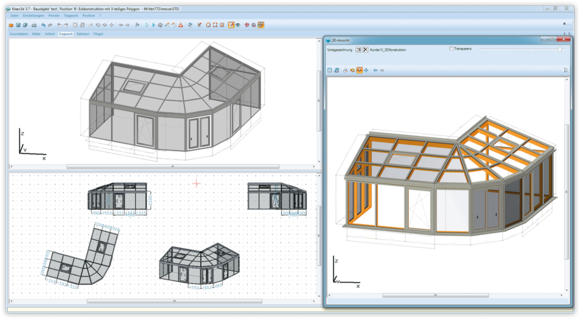
Construction & Process Optimisation
Buildings and thus, even windows, facades and building elements have been customised and constructed in Germany and Western Europe for decades and since the widespread use of PC programs at the end of the 80s, they have been planned with CAD software — be it by architects, engineers, technicians, master craftsmen or designers. Cloud solutions enable comprehensive and location-independent working and increasingly facilitate the work by using component databases (BIM etc.).
For the windows industry, there are applications that contain CAD functions as well as consistent and secure use of design data without interfaces and information gaps. Even geometrically demanding window and facade geometries and conservatories can be designed and manufactured with these 3D CAD planning tools. Standard profile systems or customised construction details can be used, which can then be implemented time and again in all projects, and which automatically adapt themselves to the respective dimensions and angles. The software can generate three-dimensional views for presentation to clients and planners (augmented reality) as well as create production data with glazing and profile lists and cutting data, which can be transferred directly to a CNC machine.
Building Integrated Modeling (BIM)
The design and planning of buildings has been carried out with the help of CAD software for more than 25 years now. But up to now, the necessary data of building materials and building elements have been missing at the beginning of the planning, so that many adjustments and changes in the work planning became necessary. Now there are a lot of advantages with enhanced IT systems, faster computers and cloud based data storage. This costs can be reduced considerably, for example because higher costs due to deviations from standard dimensions lead to increased waste or details have to be replanned. BIM offers a data model, which ideally supplements the existing CAD systems. Geometric data can be supplemented by comprehensive information to building materials and components, for example, shape, colour, possible dimensions, technical function and much more. This provides significant benefits to building owners, general contractors, building component manufacturers and planner:
- Better flow of information, since interfaces are omitted,
- All stakeholders can access current data centrally at any time ("single source of truth"),
- Quick adaptation of the existing planning and simultaneous information for the project stakeholders,
- Defined workflows with potential for ongoing optimisation and faster decision-making processes
- Greater transparency across all processes, time and quantity planning, and thus, project costs,
- Fewer errors, because geometric and functional conflicts emerge much earlier in the 3D planning process (collision management),
- Greater level of detail at an early planning phase optimises the planning process and minimises the risk (no more detailed planning at the construction site),
- Comprehensive information is available for efficient and sustainable management of the building when updating the data until acceptance.
For technically sophisticated structures (hospitals, administrative and production buildings, etc.) BIM models offer considerable advantages and are being increasingly used by big general contractors. The total benefits will lead to a constantly increasing demand for BIM planning in the future. This is already a standard practice in Scandinavia, and Germany would like to use BIM for construction projects in the public sector in 2021. This will also change the tendering practice and manufacturers must supply digital data in specified formats (openBIM exchange format IFC ) [7][6]) so that the data can be read, understood and processed by the planner.
In addition to process optimisation, simple visualisation by integration of BIM objects in CAD drawings is also an important area of application. Architects can show realistic looking products to the clients and vary them easily. This is how a "naked" building model becomes a virtual house with specific products. However, this works only if architects can work with their familiar CAD software and the user interface is easy to use. This is why architects prefer platforms with various BIM objects, which can be easily accepted in their own CAD software with the click of a mouse. This is what the BIM monitor 2019 of BauInfoConsult illustrate [6].
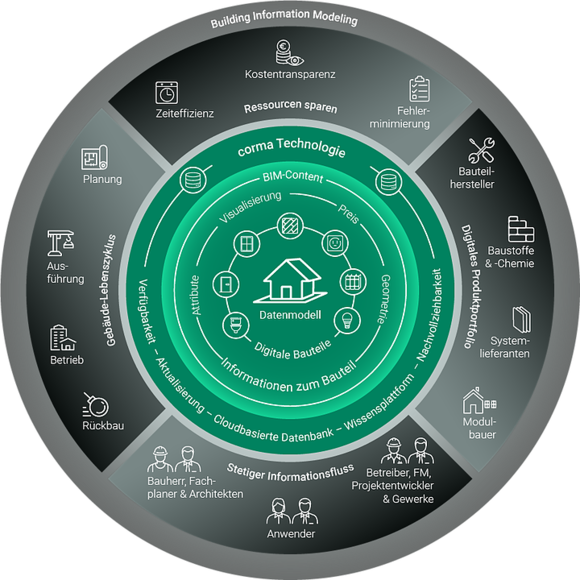
![Die Grafik zeigt den Screenshot einer BIM-Anwendung: BIM Objekte liefern alle notwendigen Informationen zu Baustoffen und Bauelementen in beliebiger Detailtiefe und ermöglichen die Übernahme in den CAD Plan und vor Baubeginn eine detaillierte Planung mit allen Funktionen und Kennwerten (Quelle: Hueck, BIM Tutorial [8])](/fileadmin/_processed_/5/e/csm_HZB2002_Bild_06_BIM-Objekt_Hueck_73a1c66394.jpg)
Hence, manufacturers who do not provide any BIM objects or provide only non-compatible BIM objects, lose this distribution channel right at the beginning of the planning process. This is why positioning the BIM objects in the download section of a company's website is not the best solution.
BIM can also provide ideal data for subsequent management. Hence, while setting up a BIM model, even data that is necessary for the utilisation of a building should be acquired. This includes information on cleaning, servicing and maintenance, room management, relocations, furnishings and workplace-related services. An interface to CAFM applications (Computer Aided Facility Management) is necessary for this purpose.
Product Information & Documentation
In the construction and expansion sector, the several interfaces, information gaps and administrative processes consume large amounts of time and money. Efficiency potential with work organisation, material logistics and installation are estimated to be 30% to 50%. With the European Construction Products Regulation (CPR) coming into force, obligations for technical documentation have been defined for manufacturers in order to prepare a declaration of performance (DoP). The manufacturer has to specify the correct characteristic values at his own responsibility and needs test certificates, design descriptions and documents of the factory production control (FPC) for this purpose. With the declaration of performance, the manufacturer declares conformity with the product standard and legally certifies compliance with technical properties and characteristic values such as thermal insulation, sound insulation, air permeability, resistance to wind load or resistance to watertightness.
This is where digital services such as a CE generator or document and verification management system offers savings in time and legal security. Ideally, this data is generated directly in the window construction software or it can easily be integrated into it. As a notified testing and certification body, ift Rosenheim has developed a database, which uses existing verifications, system passports and expert opinions of a manufacturer or system provider. Additionally, the transfer rules of DIN EN 14351-1 are saved as well as rules of interchangeability of components are defined. Processors can access this data in various window construction programs. The data of the individual order items are transferred to the CE generator with a mouse click. The CE generator then creates a declaration of performance and the CE mark as a PDF file based on the verifications saved and characteristic values. This saves time and reduces errors caused by manual data transmission. The declaration of performance must be issued in the national language in which the product is supplied, which the CE generator prepares automatically.
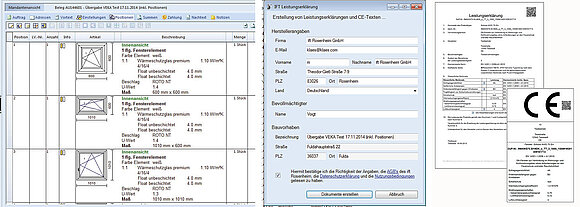
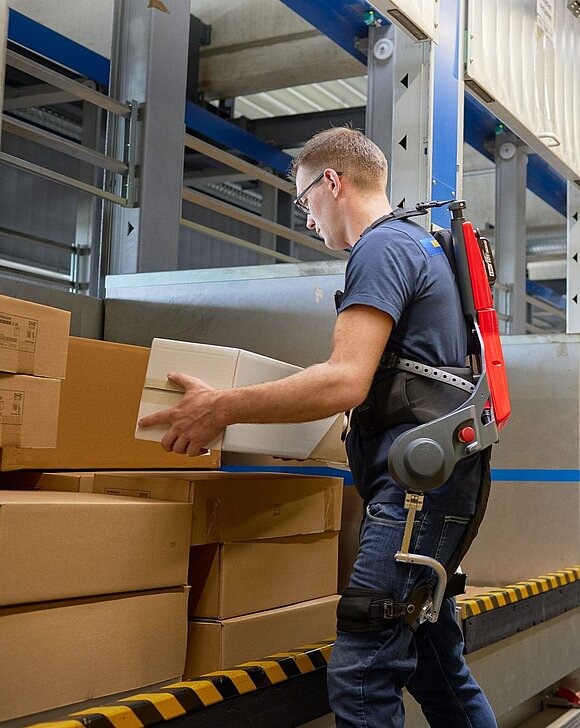
Installation
The actual assembly of windows, doors and building elements is difficult to automate. Different lifting devices are used, from mobile cranes to portable equipment, in order to facilitate the assembly of heavy elements. The use of exoskeletons from the industry is not yet possible, because the conditions on the construction site are too different and undefined, and the devices do not work reliably. However, considerable enhancements in efficiency are possible in assembly planning, logistics, interface management and documentation using EDP programs.
Installation planning and logistics
Every good assembly begins with professional installation planning, in which the specific conditions of the order, window and mounting building components are taken into consideration. Those who go to the construction site without planning makes mistakes and needs more time. The free online installation tool of ift Rosenheim supports in the professional planning of mounting the building components with respect to building physics, fastening and sealing. Technically unsuitable constructions and installation systems are ruled out by the program. After product selection (wall mounting / material, window material / profile, sealing / fastening system etc.) and the input of the dimensions, calculation pertaining to building physics for mounting building components with the calculation application WinIso validated by ift, as well as the structural design calculations are performed. The application is available in a product-neutral ift version (with creation of assembly documentation as PDF) and as a company-specific version (Adolf Würth GmbH & Co. KG, BTI Befestigungstechnik GmbH & Co. KG, Deflex Dichtsysteme GmbH, ISO-Chemie GmbH, Nüßing GmbH, SFS intec GmbH). Selectable products have the necessary tests for long-term suitability for use. For the company versions, you can also order out a compatible installation kit, for which the installation pass also contains the appropriate processing instructions for the materials.
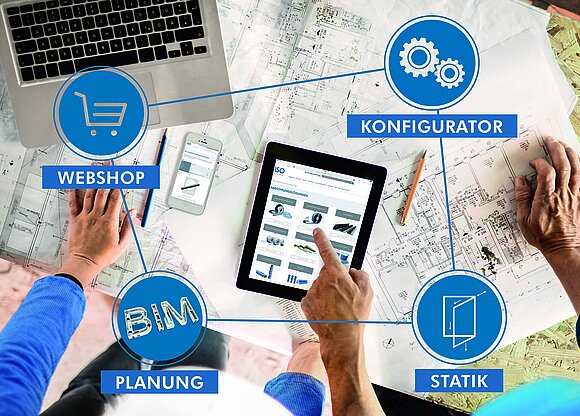
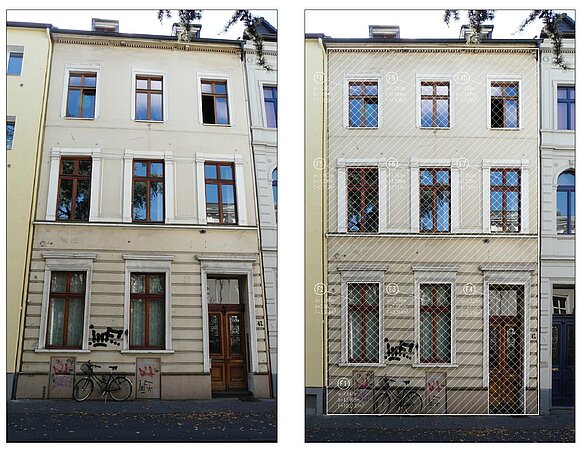
Measurement
Accurate measurement is a prerequisite for professional performance. In addition to width and height, even unevenness, angularity, the condition for mounting building components, etc. must be checked. This is where digital check lists from the Installation Guideline or the Installation Planner come to your help. For existing buildings there are often no current drawings from which dimensions can be determined. This is where digital measurement tools help, which enable determining the window size based on photos. Accuracy is around +/- 10 mm and this is sufficient for the bidding stage. The larger an existing reference dimension is (e.g. width or height of a building), the better is the accuracy. This works with the help of photogrammetric rectification, even if only height-distorted images are available, for example, facades photographed obliquely from below or building areas that are difficult to access. Most applications have an export feature, with which the dimensions can be easily integrated into a calculation program or window construction software. Some applications have modules, with which a CAD plan of the building/room can be created or the construction work can be billed by measurement according to VOB/C. As an island solution, such applications are certainly interesting to begin with, but an integrated solution offers more advantages.
Sustainability
The construction and real estate sector consume large quantities of energy and raw materials (grey energy) for the production and utilisation of buildings. In the amendment of the Construction Products Regulation (CPR), the "sustainable utilisation of natural resources" was consequently included as the seventh "essential requirement". "[…] It must be possible to recycle the building, its construction materials and parts after demolition" [...] Environmentally friendly raw materials and secondary building materials must be used for the structure." The regulation foresees an evaluation to be carried out by an SPD. At the same time, the importance of certification systems for sustainable building (LEED, BREEAM as well as BNB, DGNB) is increasingly rising, which makes it meaningful to prepare data that provides the necessary information. This is why manufacturers of building elements are obligated to determine the relevant data and product information and to hand them over to the building user, who needs these data for the period of use, conversions or disassembly. Hence, a secure long-term storage of the data is necessary.
Product passport for sustainability
ift Rosenheim has developed the Sustainability Product Passport (Nachhaltigkeits-Produktpass, NHPP) to make it easier for planners, building owners and investors to evaluate sustainability-related criteria. It contains the necessary characteristic values for certification systems such as DGNB, BNB, LEED or BREEAM. This includes a life cycle assessment report, an environmental product declaration according to EN 15804 (EPD), valid REACH manufacturers' declarations, health-related certificates (e.g. VOC certificates), certificates of sustainability (e.g. PEFC, FSC or cradle-to-cradle), declaration of the recycling proportion according to ISO 14021, but also management certification (ISO 9001, ISO 14001, ISO 50001, BS OHSAS 18001) or CSR reports (Corporate Social Responsibility). As accredited program holder for EPDs, ift Rosenheim can compile these required certificates. ift Rosenheim's sustainability product passport supports "stakeholders" such as building owners, investors, building users, architects, planners and building certifiers, but also customers, suppliers or employees with important information on ecological, social and economic aspects.
The diverse information is clearly arranged, so that the necessary characteristic values for the various building certification systems (DGNB, BNB, LEED and BREEAM) are easily available. This data can also be used as the basis for an environmental management system and the ecological optimisation of products and production.
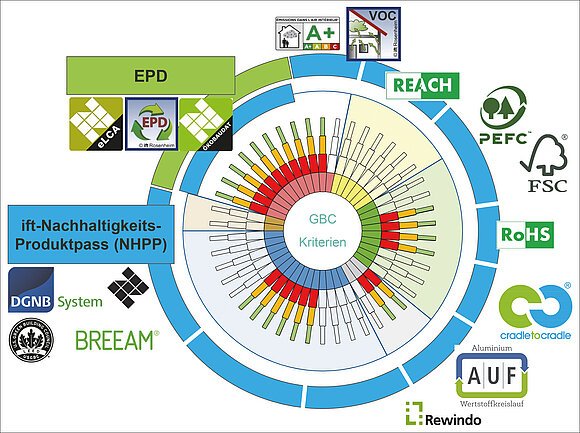
(ift sustainability passport)
Automated EPD Creation
The preparation of an Environmental Product Declaration (EPD) is like a mosaic for several items of data have to be determined from different areas, e.g. the materials used (frames, seals, fittings, glazing, etc.), production, transport and installation. This enables statements on the environmental impact of a product, for example on energy consumption, greenhouse gas (CO2) or water consumption. To support manufacturers of windows, facades, doors and gates etc. even with the preparation of product specific EPDs, ift Rosenheim has created an EPD tool, so customised EPDs for manufacturers, products and projects can be created at the click of a mouse on the basis of product-specific or project-specific data.
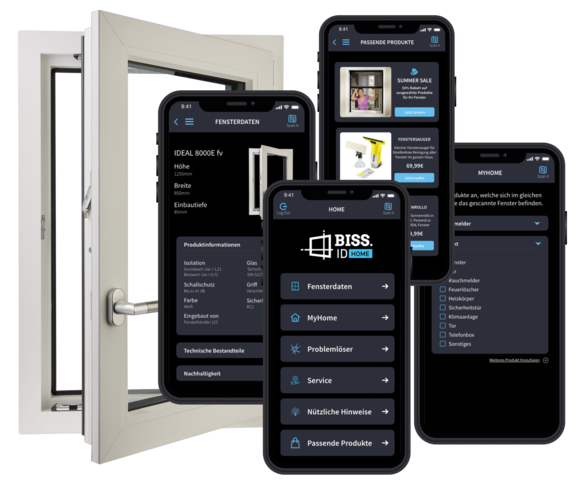
(Source: BISS.ID)
Digital maintenance and recycling
Windows, doors and gates are movable parts, whose function and service life are affected by regular maintenance. The stress depends on the number of opening cycles and the forces that occur during use. Hence, it is more intelligent to determine the maintenance cycles not dependent on the time period (e.g. once per annum) but depending on the time of use. This becomes possible if an electronic "counter" is inserted in the fitting or the window, which automatically sends information to the operator of a property after a defined number of cycles, or better yet, to a window, installation, or service company. For efficient maintenance, it is particularly meaningful if the maintenance personnel already has all the information on the window available online, for example, about the window type/profile, the screw connections, fittings and drives. In this way, all necessary spare parts can be taken along and maintenance or repair can be carried out quickly and reliably. This achieves a big plus in efficiency, reliability and safety, especially for gates in commercial buildings or in case of fire and smoke protection systems.
The Construction Products Regulation, the Closed Substance Cycle Waste Management Act and the European Waste Framework Directive all require recycling before waste. This is why individual manufacturers of window profiles and windows already save comprehensive data on the product as well as information on utilisation, care and maintenance on chips (NFC, RFID), which are installed directly in the product. This provides a secure link between product and product information and eliminates the annoying search for necessary information. It is important that the readability is simple and permanent. This digital information makes maintenance and facility management significantly easier and more efficient.
Sources and Recommendations for Information
- Das Handwerk wird digital – Bedeutung für Betriebe, Beschäftigte und Marktstrukturen ((The handicrafts enterprise is going digital — Significance for companies, employees and market hierarchies). Wolfgang Dü-rig, Jörg Weingarten, WISO-Diskurs 4/2019, Friedrich-Ebert-Stiftung (FES). library.fes.de/pdf-files/wiso/15212.pdf
- Digitalisierung des Handwerks ((Digitalisation of the handicraft enterprise).bitcom 2017. 2017https://www.bitkom-research.de/de/spotlight/research-spotlight-2017-02-digitalisierung-des-handwerks
- Umfrage „Online-Bewertungsportal – zur Relevanz von Bewertungsportalen und Internet-Siegeln“, Splendid Research 2019. www.splendid-research.com
- Umfrage „Influencer – Einfluss auf die Kaufwahrscheinlichkeit“, Splendid Research 2019. www.splendid-research.com
- www.bitkom.org – Bundesverband Informationswirtschaft, Telekommunikation und neue Medien e.V. mit ca. 2.700 Unternehmen der digitalen Wirtschaft
- BIM Monitor 2019. BauinfoConsult. Befragung von 302 Architektur-, Ingenieur-, Bau- und Installationsunternehmen. www.bauinfoconsult.de/presse/pressemitteilungen/2019/bim_2019_studie_zeigt_wie_es_aktuell_am_bau_um_bim_bestellt_ist/11952.
- Das openBIM-Austauschformat IFC, Dipl.-Ing. (Architektur) Marian Behaneck, Computer Spezial 1.2019, www.computer-spezial.de/artikel/das-openbim-austauschformat-ifc_3337560.html
- Hueck BIM-Tutorial, /www.hueck.com/alu-sys/de/de/home/informationen-services/BIM-Hueck.html
- Stefan Luber, www.bigdata-insider.de
- BEST OF BigData insider, Vogel IT-Medien GmbH, www.bigdata-insider.de
- www.bvdw.org – Bundesverband Digitale Wirtschaft (BVDW) e.V. mit ca. 700 Unternehmen der digitalen Wirtschaft
- www.gruenderszene.de – Plattform der deutschen Digitalwirtschaft
- Digitalisierung und Industrie 4.0 - Technologischer Wandel und individuelle Weiterentwicklung. Prof. Ronald Deckert, Springer Fachmedien Wiesbaden 2019


